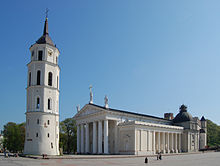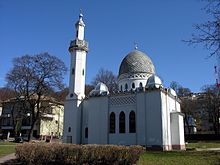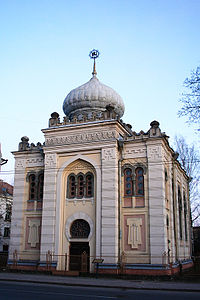| Revision as of 20:51, 6 March 2014 editIryna Harpy (talk | contribs)Extended confirmed users, Pending changes reviewers, Rollbackers43,773 editsm Reverted 1 edit by 175.156.89.67 (talk) to last revision by Esoglou. (TW)← Previous edit | Revision as of 12:35, 3 May 2014 edit undoLukas1321 (talk | contribs)38 editsm Added pie chartNext edit → | ||
| Line 1: | Line 1: | ||
| {{Pie chart | |||
| |thumb = right | |||
| |caption = Religion in Lithuania (2011)<ref>Department of Statistics to the Government of the Republic of Lithuania. ''{{cite web |url=http://www.osp.stat.gov.lt/en/web/guest/pranesimai-spaudai?articleId=223122 |title=Ethnicity, mother tongue and religion}}''. 2013-03-15.</ref> | |||
| |label1 = ] | |||
| |value1 = 77.2 | |||
| |color1 = DarkBlue | |||
| |label2 = ] | |||
| |value2 = 4.1 | |||
| |color2 = DarkOrchid | |||
| |label3 = ] | |||
| |value3 = 0.8 | |||
| |color3 = Blue | |||
| |label4 = Other religions | |||
| |value4 = 1.67 | |||
| |color4 = YellowGreen | |||
| |label5 = ] | |||
| |value5 = 6.1 | |||
| |color5 = DarkGrey | |||
| |label6 = Undeclared | |||
| |value6 = 10.1 | |||
| |color6 = SlateGray | |||
| }} | |||
| As per the 2011 census, the predominant '''religion in Lithuania''' is ], with the largest confession being ]. ] was the last ] country in Europe, with the Roman Catholic Church becoming widely accepted only in the late 14th century. In the early 21st century, about 77% of the population is Roman Catholic according to the 2011 census.<ref name="stat.gov.lt"></ref> There are also smaller groups of Evangelical ] and ] churches other ], as well as people of other faiths. Some elements of the ancient ] survives in the countryside, mingled with ].{{citation needed|date=August 2012}} | As per the 2011 census, the predominant '''religion in Lithuania''' is ], with the largest confession being ]. ] was the last ] country in Europe, with the Roman Catholic Church becoming widely accepted only in the late 14th century. In the early 21st century, about 77% of the population is Roman Catholic according to the 2011 census.<ref name="stat.gov.lt"></ref> There are also smaller groups of Evangelical ] and ] churches other ], as well as people of other faiths. Some elements of the ancient ] survives in the countryside, mingled with ].{{citation needed|date=August 2012}} | ||
Revision as of 12:35, 3 May 2014
Religion in Lithuania (2011)
Roman Catholic (77.2%) Orthodox (4.1%) Orthodox (Old Believers) (0.8%) Other religions (1.67%) Non-religious (6.1%) Undeclared (10.1%)As per the 2011 census, the predominant religion in Lithuania is Christianity, with the largest confession being Roman Catholicism. Lithuania was the last pagan country in Europe, with the Roman Catholic Church becoming widely accepted only in the late 14th century. In the early 21st century, about 77% of the population is Roman Catholic according to the 2011 census. There are also smaller groups of Evangelical Lutherans and Reformed churches other Protestants, as well as people of other faiths. Some elements of the ancient Lithuanian pagan religion survives in the countryside, mingled with Christianity.
According to the 2005 Eurobarometer Poll, regarding the question of religious or spiritual beliefs, 49% of Lithuanian citizens responded that "they believe there is a God", 36% answered that "they believe there is some sort of spirit or life-force" and 12% answered that "they do not believe there is any sort of spirit, God, or life-force".
Population by religious confession
As per the 2011 census:
- Roman Catholic – 77.2% (2,350,478)
- Orthodox – 4.1% (125,189)
- Orthodox (Old Believers) – 0.8% (23,330)
- Evangelical Lutherans – 0.6% (18,376)
- Evangelical Reformed – 0.2% (6,731)
- Sunni Muslim - 0.1% (2,727)
- Judaic – 0.04% (1,229)
- Greek Catholics (Unites) – 0.02% (706)
- Karaites – 0.01% (310)
- Other religions – 0.7% (19,926)
- No religion – 6.1% (186,670)
- Did not specify – 10.1% (307,757)
Christianity
Roman Catholicism
Main article: Roman Catholicism in Lithuania
As per the 2011 census, 77.2% of Lithuanians belong to the Roman Catholic Church Roman Catholicism has claimed the adherence of the majority of Lithuania since the Christianization of Lithuania in the 14th and 15th centuries. Lithuania kept her Catholic identity under the Russian Empire and later under the Soviet Union when some Catholic priests led the resistance against the Communist regime, which is commemorated in the Hill of Crosses near Šiauliai, a shrine to the anti-communist resistance. Political activity has continued after independence against socialism and liberalism, especially in ethical questions.
Eastern Orthodoxy

Eastern Orthodoxy claims 4.1% of the population, mainly from the Russian minority.
Lutheranism
Main article: Evangelical Lutheran Church of LithuaniaProtestants make up 0.8% of the population, with 0.56% belonging to the Evangelical Lutheran Church of Lithuania.
Lutheranism in Lithuania dates back to the 16th century, when it came mainly from the neighbouring German-controlled areas of Livonia and East Prussia. A Synod in Vilnius united the church in 1557. The parish network covered nearly all of the Grand Duchy, with district centers in Vilnius, Kedainai, Biržai, Slucke, Kojdanove and Zabludove later Izabeline. Small Protestant communities are dispersed throughout the northern and western parts of the country.
The majority of Prussian Lithuanians living in East Prussia and in Memelland (since 1945 the Klaipėda Region of Lithuania) belonged to the Evangelical Church of the old-Prussian Union. Most resettled in the West Germany after World War II along with the ethnic German inhabitants.
Since 1945 Lutheran Protestantism in Lithuania has declined.
Reformed church
The Lithuanian Evangelical Reformed Church is a historic denomination it was founded in 1557. Notable member was Szymon Zajcusz. In the second half of the 16th century the Unitarians separated. The denomination has over 7000 members in 14 congregations. The church is a member of the World Communion of Reformed Churches and the World Reformed Fellowship
Other Protestants
Various Protestant churches have established missions in Lithuania since 1990, including the United Methodists, the Baptist Union, the Mennonites, and World Venture.
Islam

In Lithuania, Islam has a long history unlike many other northern European countries. The medieval Grand Duchy of Lithuania of the Polish–Lithuanian Commonwealth allowed Muslims, notably the Crimean Tatars to settle in the lands in the south. Some of people from those lands were moved into ethnically Lithuanian lands, now the current Republic of Lithuania, mainly under rule of Grand Duke Vytautas. The Tatars, now referred to as Lithuanian Tatars, lost their language over time and now speak Lithuanian as natives; however, they have strongly maintained their Muslim faith.
Judaism
Main article: Lithuanian Jews
The Lithuanian Jewish community has roots that go back to before the time of the Grand Duchy of Lithuania. Lithuania was historically home to a large Jewish community and an important center of Jewish scholarship and culture from the 18th century until the community was almost entirely eliminated during the Holocaust. Before World War II, the Lithuanian Jewish population numbered some 160,000, about 7% of the total population. Vilnius alone had a Jewish community of nearly 100,000, about 45% of the city's total population with over 110 synagogues and 10 yeshivot in the city.
There are still communities of Jews of Lithuanian descent around the world, especially in Israel, the United States, South Africa, Zimbabwe, Brazil and Australia.
According to the 2001 census, there were 1,272 adherents of Rabbinic and Karaite Judaism. About 4,000 Jews were counted in Lithuania during the 2005 census.
Karaites

According to a Karaite tradition several hundred Crimean Karaites were invited to Lithuania by Grand Duke Vytautas to settle in Trakai ca. 1397. A small community remains in Trakai today, which has preserved the Turkic Karaim language and distinctive customs, such as its traditional dish called "kibinai", a sort of meat pastry, and its houses with three windows, one for God, one for the family, and one for Grand Duke Vytautas.
Romuva
Medieval Lithuania was the last pagan nation in Europe, officially converting in the 14th century. The neo-pagan movement Romuva, established in 1967, attempts to reconstruct and revive Lithuanian paganism.
See also
References
- Department of Statistics to the Government of the Republic of Lithuania. "Ethnicity, mother tongue and religion".. 2013-03-15.
- ^
- European Union. "Eurobarometer on Social Values, Science and technology 2005 - page 11" (PDF). Retrieved 2007-05-05.
- Department of Statistics to the Government of the Republic of Lithuania. "Ethnicity, mother tongue and religion".. 2013-03-15.
- "Population by religious community indicated, municipalities".. 2013-03-15.
- Foreword to the past: a cultural history of the Baltic people by Endre Bojtár, p. 140
- ^ Template:Lt icon "Romos katalikų daugiausia" (PDF). Department of Statistics to the Government of the Republic of Lithuania. 2002-11-07.
- http://www.ref.lt/index.php/en/english/1-english
- http://wrfnet.org/web/guest/aboutwrf/membershiplist
- Template:En icon United Methodists evangelize in Lithuania with ads, brochures
- Template:En icon Baptist beginnings in Lithuania.
- Template:En icon Graduation: Lithuania Christian College
- Template:En icon World Venture. Lithuania.
- Islamic peoples of the Soviet Union, by Shirin Akiner, pg. 85
- Lithuania
- The Virtual Jewish History Tour - Vilnius
- Vilnius, Jerusalem of Lithuania
- Template:Lt icon "Gyventojai pagal tautybę ir tikybą". Department of Statistics to the Government of the Republic of Lithuania.
- Lithuanian population by ethnicity
- A history of pagan Europe by Prudence Jones, Nigel Pennick, p. 173
| Religion in Europe | |
|---|---|
| Sovereign states |
|
| States with limited recognition | |
| Dependencies and other entities | |
| Other entities | |
| Lithuania articles | ||||||||||
|---|---|---|---|---|---|---|---|---|---|---|
| History |
|  | ||||||||
| Geography | ||||||||||
| Politics |
| |||||||||
| Economy | ||||||||||
| Society |
| |||||||||